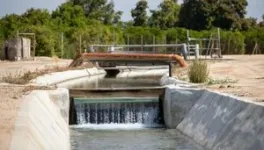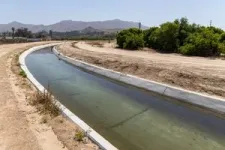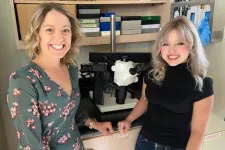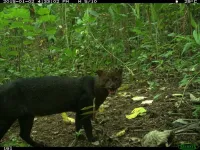(Press-News.org)
California should take urgent and bold measures to adapt its $59 billion agriculture sector to climate change as the amount of water available for crops declines, according to a collaborative report by University of California faculty from four campuses.
Published in the Proceedings of the National Academy of Sciences, the report provides a roadmap for more water capture, storage, and distribution systems that are in harmony with climate projections and ecosystems. It further considers how runoff and groundwater can be used repeatedly as it flows generally from mountainsides to coastal lands.
“The availability of water for consumption is decreasing because of climate change, partly due to increased evaporation and transpiration but also because we don't have the system set up to capture and use the larger and more variable flows that are now the norm,” said Kurt Schwabe, a public policy professor at UC Riverside and co-author of the report.
A warmer planet means fewer but larger rain and snowstorms in California. The rising temperatures and shorter winters also result in smaller volumes of water stored in mountain snowpacks that have historically replenished California’s reservoirs each spring. And a greater amount of water is getting lost through evaporation.
This means that agriculture, which uses about 80 percent of the water consumed in the state, will need to adjust to a future with less water available for irrigation.
To help reduce the overall impact on agriculture and society from climate change, the report’s authors envision a more nimble and responsive system that can capture and store water from big storms before it goes to sea to prevent floods and keep crops growing through the hot, dry summer months.
To do so, California must increase its water storage capacity, but that doesn’t necessarily require building more dams and reservoirs, Schwabe said. Great storage capacity now exists in the state’s depleted aquifers below the Central Valley and the coastal plains.
“It’s really a huge win,” Schwabe said. “We can start taking more of those flood flows, and unexpected overflows, and put them in these groundwater aquifers. We’ve got plenty of capacity there, and you don't suffer from the evaporation rates that you do with the surface reservoirs.”
Capturing the flows would involve diverting torrents from heavy rains and accelerated snowmelts to farm fields or to habitat lands where controlled flooding would cause no harm, and the water would percolate down to aquifers. Farmers would then have more groundwater to get through drier periods while also reviving wildlife habitats.
Farmers also should take advantage of new crop varieties, so they have more flexibility to deal with different water situations. Changing crops, unlike changing irrigation systems, is a practice that can lead to reduced overall water use.
“It’s obviously an economic decision confronting the growers,” Schwabe said.
However, switching from a water-intensive practice such as flood irrigation to something like drip irrigation, doesn’t necessarily save much water at the system level, he said. Flood irrigation may be appropriate if it helps recharge aquifers, or the runoff is used again by other farms.
“Sometimes the runoff water appears later in the system for use,” Schwabe said
California also needs to build more flexibility into its water delivery systems. The state’s three major aqueducts — the California State Water Project, the Central Valley Project, and the Colorado River Aqueduct — for the most part transport water from north to south. A greater ability to move water from east to west and vice versa would allow for more efficient water use. Farmers who have more water than they need for a particular season could sell to others in need. With prices based on scarcity plus delivery costs, such a marketplace would have incentives for storage and efficient use, Schwabe said.
The report’s title is “Cultivating Climate Resilience in California Agriculture: Adaptations to an Increasingly Volatile Water Future.”
In addition to Schwabe, the report’s co-authors are Josué Medellín-Azuar at UC Merced, Alvar Escriva-Bou at UCLA, and Amélie Gaudin and Daniel Sumner at UC Davis.
“When I moved to California over 20 years ago, someone told me, “Don’t let people tell you there isn’t a lot of water in California because there is. The problem is that it’s just managed really poorly,” Schwabe said.
That said, Schwabe believes the state is making progress by developing policies that can lead to more efficient and sustainable outcomes, such as the Sustainable Groundwater Management Act of 2014.
“Today more than ever before we’re seeing partnerships across environmental, agricultural, and municipal sectors to address water scarcity issues,” Schwabe said. “And that’s a good thing.”
END
If you’re trying to keep drivers from picking up their phones, make it a game, according to a new Proceedings of the National Academy of Sciences (PNAS) study led by researchers from the Perelman School of Medicine at the University of Pennsylvania. When drivers could earn points for making reductions in handheld phone use and had the chance to compete in a weekly leaderboard of others like them, researchers saw as much as a 28 percent reduction in handheld phone use while driving, a habit that stuck once the intervention—and the games—ended.
“Distracted driving ...
A study reported in Proceedings of the National Academy of Sciences (PNAS) shows how the presence of a specific protein called IL-22BP affects the composition of the gut microbiota and the body’s response to bacterial infection.
“We discovered that mice that don’t produce this protein are more protected against intestinal infections by bacteria like Clostridioides difficile and Citrobacter rodentium,” Marco Aurélio Ramirez Vinolo, a co-author of the article, told. He is a professor at the State University of Campinas’s Institute of Biology (IB-UNICAMP) in Brazil and head of its Immunoinflammation Laboratory.
IL-22BP ...
URBANA, Ill. -- A bad case of the flu during pregnancy can increase the risk for fetal neurodevelopmental disorders such as schizophrenia and autism spectrum disorder. But it’s not the virus itself doing the damage; it’s the mother’s immune response.
New University of Illinois Urbana-Champaign research using live mouse-adapted influenza virus improves upon previous mouse experiments to explain the process on a cellular and molecular level. It also indicates fetal brain changes are more likely once the severity of the mother’s infection meets a specific threshold.
“Our data provide really compelling evidence for an infection severity ...
DURHAM, N.C. -- It sounds fantastical, but it’s a reality for the scientists who work at the world’s largest particle collider:
In an underground tunnel some 350 feet beneath the France–Switzerland border, a huge device called the Large Hadron Collider sends beams of protons smashing into each other at nearly the speed of light, creating tiny eruptions that mimic the conditions that existed immediately after the Big Bang.
Scientists like Duke physicist Ashutosh Kotwal think the subatomic debris of these collisions could contain hints ...
The research, led by Dr Lisa Quadt, Research Fellow in Psychiatry at BSMS and Dr Jessica Eccles, Reader in Brain-Body Medicine at BSMS, highlights a significant link between neurodivergence and chronic fatigue. The study found that increased inflammation in childhood, often resulting from heightened stress levels, may be a contributing factor. This supports previous findings that suggest chronic fatigue can be rooted in inflammatory processes.
“These results show the importance of trans-diagnostic screening for children and the need for better support for neurodivergent children” says Dr Quadt. “Children with neurodivergent ...
AMES, Iowa – Pay attention the next time you drive near your home, farm or business. You’ll notice small, green utility boxes all over the place. They’re distribution transformers. If they’re not working properly, electricity won’t flow to your lights and appliances.
Those boxes take kilovolts of electricity (that’s high voltage, measured in 1,000s of volts) from transmission lines and step it down to the safer, practical 120 or 240 volts that power our daily lives.
“Utilities have plenty of them,” said Zhaoyu Wang, an Iowa State University professor of electrical and computer engineering. “Most of them only ...
Portland State University (PSU) has been awarded $1,976,806 from the National Oceanic and Atmospheric Administration's (NOAA) National Sea Grant Marine Debris Challenge Award Program to lead an innovative and collaborative three-year project to address microplastic pollution on the Oregon coast.
This grant is part of a $27 million project between the U.S. Department of Commerce and NOAA. Portland State will host one of 11 projects that received a total of $25 million in funding across Alabama, California, Florida, Illinois, Massachusetts, New York, North Carolina, Oregon, Texas and Wisconsin. These projects ...
ROCKVILLE, Md. – July 29, 2024 – The Association for Molecular Pathology (AMP), the premier global molecular diagnostic professional society, today announced the recipients of this year’s Excellence in Molecular Diagnostics, Jeffrey A. Kant Leadership, and Meritorious Service Awards. These prestigious accolades will be presented to the winners this November during AMP’s 2024 Annual Meeting & Expo in Vancouver, British Columbia.
Award for Excellence in Molecular Diagnostics
Atul Butte, MD, PhD
Priscilla Chan and Mark Zuckerberg Distinguished ...
An analysis of pre-treatment tumor specimens from 105 patients with localized muscle-invasive bladder cancer found that the presence of a mutation in any one of three genes, all known to be involved in DNA damage repair, was associated with complete pathologic response to cisplatin-based neoadjuvant chemotherapy as measured by pathological downstaging at the time of bladder surgery. Results are published in the journal European Urology.
“The SWOG S8710 randomized trial provided Level 1 evidence supporting ...
In the fight to mitigate climate change and deforestation in the tropics, timber plantations have emerged as a promising strategy for reforesting degraded land and connecting patches of natural forest. Often, these are species with commercial value for landowners but are not native to the region. To evaluate how well non-native tree plantations support native wildlife in heavily human-impacted areas, researchers from the Smithsonian Tropical Research Institute (STRI), the Max Planck Institute of Animal Behavior (MPI-AB), Wageningen University & Research, and the University of California – Davis surveyed over 200 hectares of timber plantations ...







